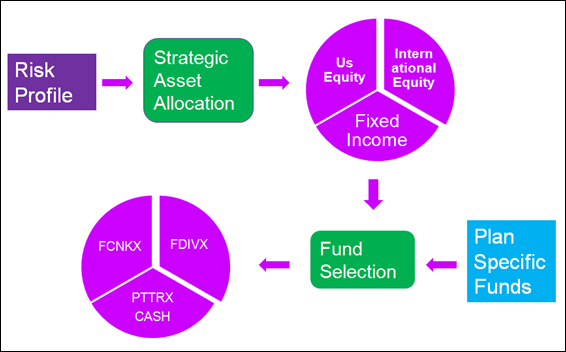Strategic Asset Allocation Equal Weight
Strategic Asset Allocation (SAA) is based on the main stream Modern Portfolio Theory: an investor decides asset allocation among major asset classes, based on personal long term risk and asset return expectations. Such an allocation is called strategic as it is meant to be long term oriented and should be only adjusted when some major events such as job change, getting closer to retirement etc. happen. As any asset allocation strategy, two critical factors should be considered:
- Risk tolerance: Being too aggressive could have damaging psychological and financial effects when markets perform poorly: often, investors are too late to realize that the portfolio is severely damaged and cannot bear with the risk anymore. Changing the portfolio allocation mix during market bottoms can have long term damage. On the other hand, being too conservative may not achieve the long term investment goal. Investors should pay careful attention to deciding the risk tolerance.
- Diversification: It is critical to diversify a portfolio into various uncorrelated assets. Different assets behave differently during different economic and market cycles. As long as these assets have reasonable long term expected returns, the diversification smoothes out the volatility of a portfolio and helps the portfolio to achieve better risk-adjusted return.
Major assets include US equity (which could be further decomposed into small, mid and large cap with value and growth styles), International equity, emerging market equity, real estate investment trusts (REITs) (US and and international), commodities and fixed income (consisting of US corporate bonds with investment grade or high yield (junk), treasury bonds with short, intermediate and long term maturity, inflation protected treasury (TIPs), foreign and emerging market bonds).
Strategic Asset Allocation – Equal Weight first divides available funds in a plan into two major categories: risky assets and fixed income assets. Other than high yield bonds, all other fixed income funds (including money market funds) are classified as fixed income assets. The Risk profile number is used to determine the target allocation of the fixed income assets. Among each of the two major classes, it then uses an equal weight method to further allocate the portfolio into major asset classes.
The following illustrates the process of this strategy:
In addition to the asset allocation, this strategy uses an advanced Fund Selection method to pick funds with the best risk-adjusted returns in an asset class from a plan when rebalancing. For example, in an article published in Journal of Asset Management (May, 2007), B. Arshanapalli , L. Switzer and K. Panju concluded that active multi-style rotation strategies can be devised to outperform the best performing buy-and-hold portfolio. Various articles have reached similar conclusions.
A strategic asset allocation strategy is sometimes also called ‘static’, ‘lazy’ and ‘buy and hold’ strategy. Among them, there are several popular portfolios proposed by well known investors:
- Roger Gibson’s diversified asset allocation portfolio
- David Swensen’s Yale individual investor portfolio
- Ted Aronson’s diversified portfolio
- William Bernstein four asset portfolio.
See Also
- Martin Gruber, Stephen Brown, William Goetzman, “Modern Portfolio Theory and Investment Analysis”. Willey, 7th Edition, 2006.
- Roger Gibson. “Asset Allocation: Balancing Financial Risks”. McGraw-Hill. 2007.
- William Bernstein, “The Four Pillars of Investing: Lessons for Building a Winning Portfolio”. McGraw-Hill. 2002.
- Gary Gorton, Geert Rouwenhorst. “Facts and Fantasies about Commodity Futures“.Yale University Research Paper. 2004.
- David Swesen, “Unconventional Success: A Fundamental Approach to Personal Investment”. Free Press, Aug 2, 2005.
- Paul Farrell, “Marketwatch.com Lazy Portfolios”. marketwatch.com. It maintains a list of lazy portfolios including the one called “Yale U’s Unconventional” and “Aronson Family Taxable”.
- William Bernstein, The July 1997 Coward’s Portfolio. www.efficientfrontier.com, 1997.
- Doron Avramov, Russ Wermers, “Investing in mutual funds when returns are predictable”. Journal of Financial Economics 81 (2006) 339–377. For fund selection.
You can also find more educational resources on strategic asset allocation in the following web site:
- Smart401K.com: a service that gives you advice on your 401k portfolios
- Marketriders.com: a serivice that gives you ETF portfolios
- Amerivest.com: TDAmeritrade portfolio service that gives you ETF or mutual fund portfolios.
Unlike the above services that charge fees, MyPlanIQ gives you Strategic Asset Allocation portfolios for free.

